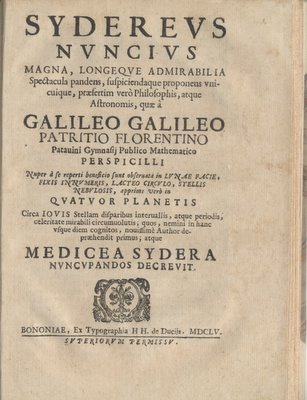Galileo's Sidereus Nuncius 3rd Edition

This is one of those pieces that does not have a direct relationship to the race to the Moon. It is the indirect relationship that makes this item so interesting. The history of Sidereus Nuncius (The Sidereal "Starry" Messenger) starts in 1609 when Galileo Galilei improved the spyglasses that were being built in Holland. Pointing his new instrument to the sky, Galileo found new sights in the heavens. Mountains on the Moon, fixed stars in the Milky Way and four moons of Jupiter revealed themselves to Galileo. Galileo wrote and published his findings in Sidereus Nuncius in 1610, which became one of the most dramatic scientific books ever published.

Galileo's discovery of mountains on the lunar surface, which had so long been traditionally thought to have a smooth surface, was pictured in his book by the use of woodcuts as pictured on the pages above. So we have the mountains on the Moon.
Galileo was also known for his scientific experiments with gravity in which he dropped two objects of different weight from a height and they hit the ground at the same time. This demonstration illustrated the effects of gravity.

How does this all relate to Apollo? David Scott commanded the Apollo 15 mission to the Moon. The Lunar Module "Falcon" landed near the Hadley Rille in the Apennine Mountains region on the lunar surface. At the end of the final EVA at his landing site on the Moon's surface, Colonel Scott paid tribute to Galileo Galilei and science, by duplicating the same experiment in an actual vacuum on the Moon. Scott dropped his geology hammer and a falcon feather and they hit the lunar surface at the same time, thus proving Galileo right.
At Burbank in 2004, I asked Colonel Scott to inscribe my 3rd edition of Sidereus Nuncius (published in 1625). He turned to the woodcut pictures of the Moon's surface in the book and wrote, "I proved Galileo right on the Moon!" He signed David Scott, Apollo 15, CDR beneath the inscription.
Sometimes unrelated pieces have something in common. The trick is to find that relationship.





